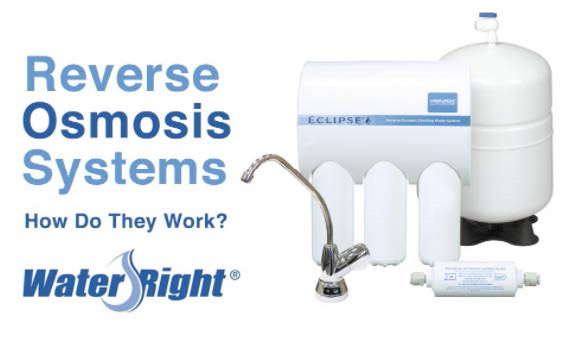If you have ever poured yourself a glass of water from a Reverse Osmosis System, you recognize it at once as the way water should taste. No sulfur smell, no metallic tang – just clean, crisp, pure water.
Water quality can vary wildly in both flavor and quality, with some specimens containing heavy metals and others testing positive for other unhealthy contaminants.
Reverse Osmosis is the simplest, most reliable system to provide your family with clean, refreshing drinking water straight from your tap.
What is Reverse Osmosis and how does it work?
In osmosis, plants draw water and nutrients up from the soil through their roots. This concentrates the water and all that it contains. Reverse Osmosis works to do the opposite, drawing the water through a semi-permeable membrane, eliminating certain undesired ions, particles, and minerals from your drinking water. The membrane works on the most microscopic levels as a filter, allowing only clean water molecules to pass through. All unwanted particles and contaminants are collected and flushed away.
As simple as it sounds, there are many steps and moving parts in a Reverse Osmosis Filtration System. You may have noticed that a Reverse Osmosis System features 3 cylinders. One is the membrane, and the other two are carbon filters. Each serves its own purpose. Let’s break it down.
Step 1: Remove large sediment and debris [pre-filtration]
This step protects the membrane from damage by removing larger particles and dissolved solids. It also removes chlorine, which could cause damage to membranes.
The first cartridge in the system is called the carbon block or sediment filter. Its job is to defend the membrane against excess sediment and exposure to damaging chlorine. The membrane pores are so fine that they can easily become clogged by large particles and contaminants. The Carbon Block Filter ensures that the membrane is able to function properly by preventing the passage of anything too large for the membrane’s filter.
Step 2: That Magical Membrane
Once your water has been through the pre-filtration process, the step that separates Reverse Osmosis from other filtration systems takes over.
Water is pressure-forced through a semi-permeable membrane. The fine pores allow only the passage of clean water molecules, filtering out sodium, chlorine, urea and bacteria, calcium, glucose, and even viruses.
R.O Systems have been tested and are certified to reduce lead, hexavalent and trivalent chromium, barium, selenium, arsenic, nitrates and nitrites, cadmium, fluoride, nitrates, nitrites, copper, radium, cryptosporidium, and dissolved solids.
Our use of thin film composite membranes ensures a resistance to bacteria breakdown, and boasts a rejection rate of 95-97 percent. A carbon filter is necessary for the success of the thin composite membrane, as they are not resistant to chlorine.
Step 3: Second Carbon Filter
Our system takes no prisoners when it comes to your water. A second carbon filter polices your water, ensuring any particles that may have passed the first two systems are eliminated before making the final journey to your drinking supply. Any unlikely breakdown in the first two steps is caught by the second carbon filter. It’s your insurance policy on clean water. Your now triple-filtered water is then sent to a storage tank and headed for your tap.
Step 4: Final Polish
The final step in your purification process is an in-line activated carbon filter. You would recognize its use in your standard pitcher filtration as the only step taken, but in an R.O System, it is only the least of our efforts. It offers one last pass through activated carbon to ensure only the purest water reaches your family. This final barrier ensures that no unpleasant flavors or odors reach your cup, leaving you with truly clean, fresh tasting water.
Who Would Benefit from a Reverse Osmosis System?
Hard water isn’t just hard on your skin, it’s hard on the many appliances your home needs to function. Washing machines, water heaters, dishwashers, shower heads, drains, and even your RO System are all negatively impacted by hard water. Soft water is better for most homes, but a water softener adds sodium to your drinking supply.
Your Reverse Osmosis system doesn’t just work better with a water softener, your softened water tastes better with the help of Reverse Osmosis!
If you have any concerns about the quality of your water or are unhappy with the smell of taste of your drinking supply, a Reverse Osmosis System may be your solution to drinking less pollution!


